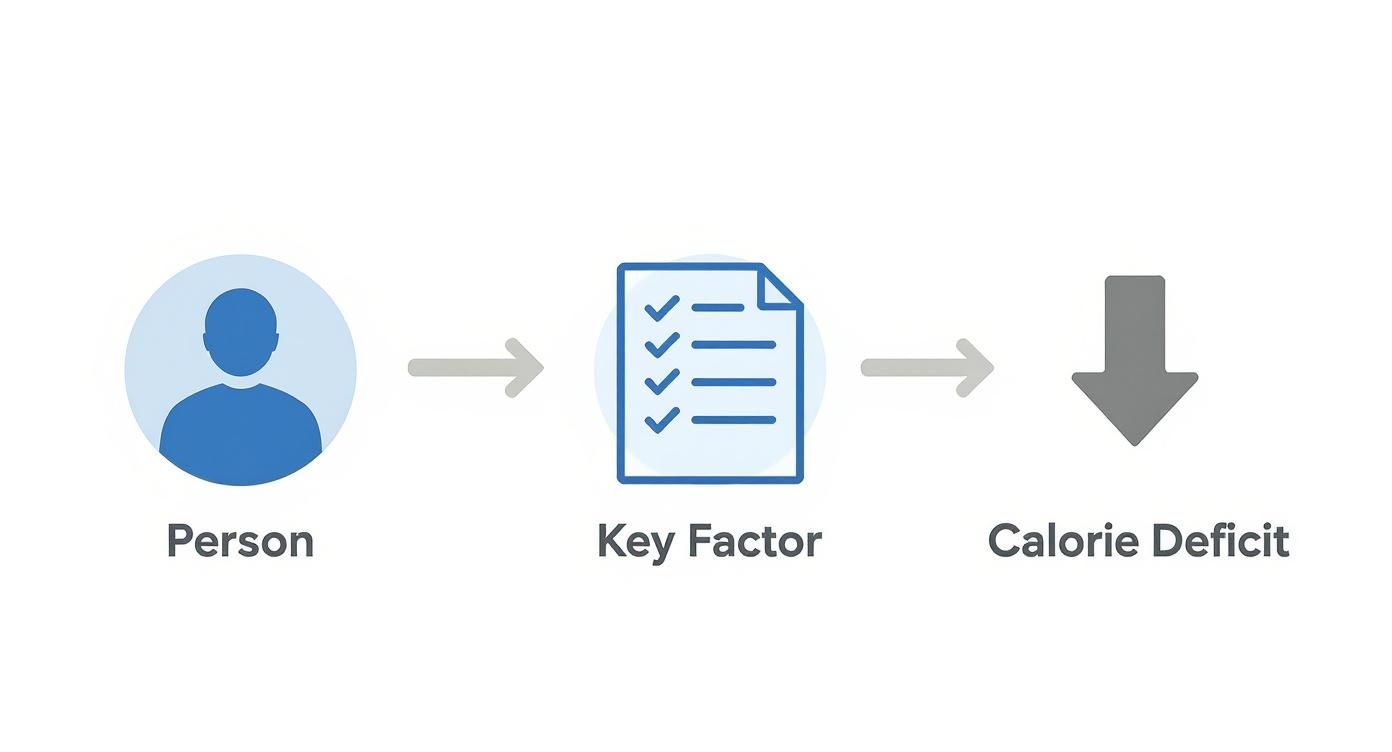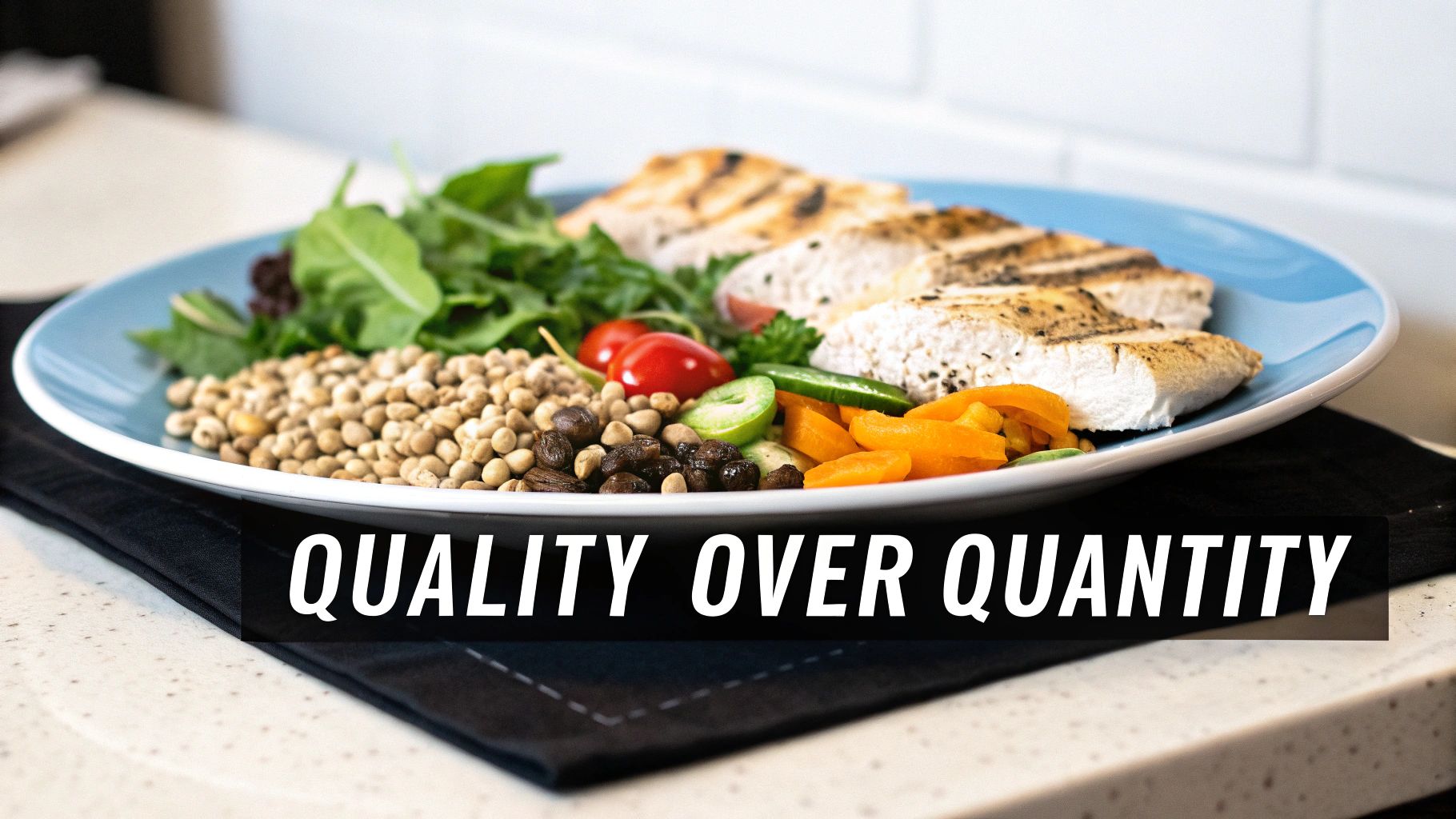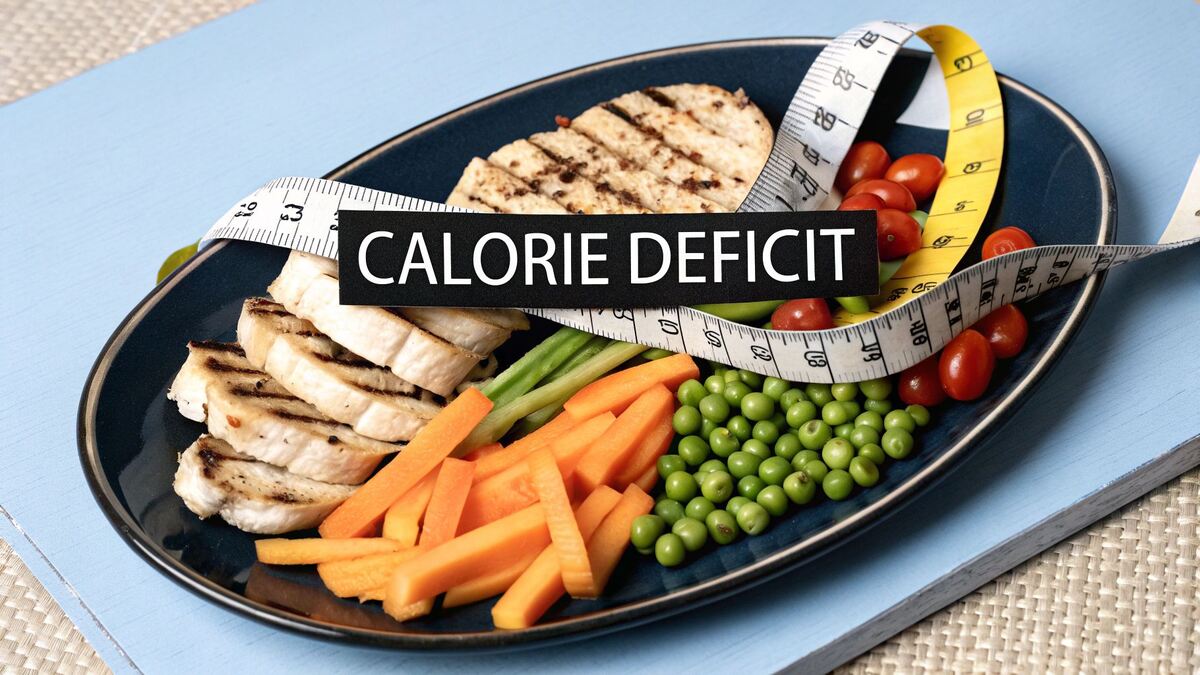How Many Calories to Lose Weight?
When it comes to weight loss, the most reliable and proven method is creating a daily calorie deficit of 500–750 calories. This sweet spot is enough to trigger steady weight loss of about 1-2 pounds per week without sending your body into starvation mode or forcing you into a miserable crash diet.
The Real Answer to How Many Calories You Should Eat
Everyone wants a single magic number for weight loss, but the truth is, there isn't one. The ideal calorie intake is completely unique to you. Your body's specific energy needs are shaped by a handful of personal factors that we'll break down here.
Think of your body like a car. A high-performance sports car is going to burn through fuel differently than a small, efficient hybrid. In the same way, how your body uses energy (calories) depends entirely on your unique makeup.
Your Personal Calorie Blueprint
The number of calories you need isn't some static figure you can pull off a generic chart. It’s a dynamic target based on your metabolic reality. Before you can figure out your target, you have to understand what drives your body's energy use in the first place.
Here’s a quick look at the core factors that come together to determine your personal calorie needs.
| Factor | Why It Matters for Calorie Calculation |
|---|---|
| Age | Your metabolism naturally slows down as you get older, which means your calorie requirements tend to decrease over time. |
| Sex | Men generally have more muscle mass and less body fat than women, leading them to burn more calories, even at rest. |
| Current Weight & Height | It takes more energy to power a larger body. Your current size is one of the biggest factors in your baseline calorie burn. |
| Activity Level | This is a huge variable. Someone with a desk job has vastly different needs than a construction worker or a marathon runner. |
Getting a handle on these personal metrics is the first step toward crafting a plan that’s actually built for you, not for a generic average. While exercise is incredibly important for your overall health, managing your food intake is the most powerful lever you can pull for weight loss.
Don't just take my word for it. Recent research makes it crystal clear: in high-income countries, it's excess calorie intake—not a lack of physical activity—that's the main driver of weight gain. In fact, a major 2023 study found that differences in energy expenditure accounted for only about 10% of the variation in obesity rates. The other 90%? It was attributed to higher calorie consumption. You can read the full research about these diet findings.
This insight really hammers home why focusing on your calorie intake is so effective. It’s not just about crunching numbers; it’s about creating a sustainable energy balance that fits your body and your lifestyle.
Of course, numbers are only part of the story. For a deeper dive, it's worth understanding the debate around counting calories versus a holistic approach to health. This guide will give you the tools to build that personalized approach, starting with the math.
Finding Your Personal Calorie Baseline
Before you can even think about a calorie deficit, you need to know your starting line. We call this your maintenance level—the total number of calories your body burns on an average day just keeping you alive and moving. Think of it as your personal energy budget. Everything starts here.
The first piece of this puzzle is your Basal Metabolic Rate, or BMR. This is the rock-bottom number of calories your body needs simply to exist at rest. It’s the energy required for basic functions like breathing, circulating blood, and cell production. The gold standard for calculating this is the Mifflin-St Jeor equation.
This infographic breaks down the entire process, showing how we get from your personal stats to a smart, actionable calorie target for weight loss.

As you can see, it's a logical path from who you are to what you need to do.
The Mifflin-St Jeor Formula
Alright, let's get into the math. The formula is a little different for men and women because of typical differences in body composition.
- For Men: BMR = (10 × weight in kg) + (6.25 × height in cm) - (5 × age in years) + 5
- For Women: BMR = (10 × weight in kg) + (6.25 × height in cm) - (5 × age in years) - 161
Let's walk through a real-world example. Meet Sarah, a 35-year-old woman who is 168 cm (about 5'6") tall and weighs 75 kg (around 165 lbs).
Plugging her numbers into the formula, we get: (10 × 75) + (6.25 × 168) - (5 × 35) - 161 = 750 + 1050 - 175 - 161 = 1,464 calories.
This means Sarah’s body burns roughly 1,464 calories every single day, even if she did nothing but rest. But people don't just lie in bed all day, which brings us to the next crucial component.
Don't Forget to Factor in Your Activity Level
Your BMR is just the foundation. To get the full picture—your Total Daily Energy Expenditure (TDEE)—we have to account for all the movement you do, from walking to the car to hitting the gym. This is your true maintenance number.
Your TDEE is arguably the most important number in your weight loss journey. It represents your break-even point. Consistently eating above it leads to weight gain, while staying below it results in weight loss. It’s that simple.
To nail this, you have to get good at tracking what you eat. A huge part of that is knowing how to effectively read nutrition labels so you can make choices that align with your goals. It's a non-negotiable skill for accurate calorie counting.
Now, find your lifestyle in the table below and multiply your BMR by the corresponding number. Be honest with yourself here!
Activity Level Multipliers for TDEE Calculation
Find your lifestyle category to accurately calculate your Total Daily Energy Expenditure (TDEE).
| Activity Level | Description | Multiplier |
|---|---|---|
| Sedentary | Office job, with little to no exercise | 1.2 |
| Lightly Active | Light exercise or sports 1-3 days per week | 1.375 |
| Moderately Active | Moderate exercise or sports 3-5 days per week | 1.55 |
| Very Active | Hard exercise or sports 6-7 days per week | 1.725 |
| Extra Active | Very hard exercise, physical job, or training twice a day | 1.9 |
Choosing the right multiplier is key to getting an accurate TDEE. Most people tend to overestimate their activity level, so when in doubt, it's often wise to choose the lower of two options.
Let's go back to Sarah. She has a desk job but makes it to the gym three times a week. That puts her squarely in the moderately active category.
So, her TDEE would be: 1,464 (BMR) × 1.55 (Activity Factor) = 2,269 calories.
This is the magic number for Sarah. To maintain her current weight, she needs to eat around 2,269 calories per day.
Creating a Smart and Sustainable Deficit
Alright, you've got your maintenance number. Now comes the part where the magic happens: creating the calorie deficit that actually leads to weight loss. This is a crucial step, and frankly, it's where a lot of people trip up.
The first instinct is often to slash calories dramatically. We think, "the faster, the better," but that all-or-nothing approach almost always backfires.
Think of this as a marathon, not a sprint. A massive, aggressive deficit might get you some quick wins on the scale, but it's a recipe for disaster. You'll likely lose muscle, feel drained, and battle intense cravings that lead to burnout and gaining all the weight back.
Aim for Sustainable Progress, Not Perfection
Instead of a drastic cut, the smart play is to create a small, manageable deficit. I've found that a sensible reduction of 10-20% from your maintenance calories is the real sweet spot for sustainable fat loss.
For most people, this works out to a daily deficit of about 300-600 calories. This moderate approach nudges your body to use stored fat for energy while holding onto your hard-earned muscle and keeping your energy levels from tanking. It’s about working with your body, not against it.
Let's go back to our example, Sarah, whose maintenance TDEE was 2,269 calories.
- A 15% Deficit: 2,269 calories × 0.15 = 340 calories.
- Her New Daily Target: 2,269 - 340 = 1,929 calories per day.
This small tweak is barely noticeable hunger-wise, but it's powerful enough to create consistent, lasting results. It’s a total game-changer because it feels doable, day in and day out.
Why Small Deficits Win in the Long Run
A smaller deficit is also key to preventing your body from hitting the panic button. When you cut calories too low, your body can go into "starvation mode," slowing down your metabolism to conserve energy. This makes losing more weight incredibly difficult. We want to avoid that at all costs.
Creating a sustainable deficit is all about finding a balance you can actually live with. The goal isn't just to lose the weight; it's to build habits that let you keep it off for good. Extreme diets give you temporary results, but consistency is what delivers permanent change.
Figuring out how to build satisfying meals within this new calorie goal can feel overwhelming at first. A good meal plan can take the guesswork out of the equation and make sure you're getting the right balance of nutrients. If you need some ideas, exploring a balanced meal plan can give you the structure and recipes to stay on track without ever feeling deprived.
At the end of the day, the best answer to "how many calories should I eat to lose weight?" is a number that lets you make steady progress without making you miserable. A 300-600 calorie deficit is smart, effective, and sets you up for success that lasts a lifetime.
Focusing on Nutrient-Dense Calories

Alright, you've got your target calorie number. That's a huge step. But now we need to talk about something just as important: the kind of calories you're eating.
Let’s be real for a second—not all calories are created equal. Where those calories come from completely changes the game. It affects how hungry you feel, how much energy you have, and ultimately, how successful you’ll be.
Imagine a 500-calorie meal. It could be grilled chicken with a side of quinoa and roasted broccoli. That meal is packed with protein, fiber, and complex carbs that will keep you feeling full and energized for hours.
Now, picture another 500-calorie "meal"—a big, sugary pastry. It’s mostly refined flour and sugar. Sure, it tastes good for a minute, but it will spike your blood sugar and leave you crashing and hungry again in no time. Same calorie count, worlds apart in how they impact your body.
The Power of High-Volume, Low-Calorie Foods
The secret to feeling satisfied while eating fewer calories is to load up on high-volume, low-calorie foods. These are the foods that fill up your plate (and your stomach) without taking a massive bite out of your daily calorie budget.
This isn't about restriction; it's about eating smarter. Here are some of my go-to options:
- Leafy Greens: Spinach, kale, and all kinds of lettuce are your best friends. You can pile your plate high with a massive salad for a tiny fraction of the calories you'd get from a handful of chips.
- Non-Starchy Veggies: Think broccoli, cauliflower, bell peppers, and zucchini. They're loaded with fiber and water, which are key for feeling full.
- Lean Proteins: Chicken breast, fish, turkey, and Greek yogurt are non-negotiable for keeping hunger at bay and holding onto muscle.
- Berries: When you need something sweet, grab some strawberries, blueberries, or raspberries. They’re full of fiber and antioxidants for very few calories.
This focus on food quality isn't just a niche strategy; it’s a global shift. A 2021 survey across 30 countries found that while 41% of people trying to lose weight focus on calories, even more people target the quality of those calories by cutting back on sugar (62%) and processed foods (31%). You can discover more insights about these global weight loss actions and see how people worldwide are approaching it.
This just goes to show that people everywhere are realizing that the type of food you eat matters just as much as the quantity.
Balancing Your Macronutrients
Going one step further, it's not just about whole foods—it's also about balancing your macronutrients: protein, carbohydrates, and fats. Each one plays a critical role in your body, especially when you're trying to lose weight.
Protein, in particular, is your powerhouse. It’s the most satiating macronutrient, which is just a fancy way of saying it keeps you feeling fuller for longer. It also helps you preserve muscle while you're in a calorie deficit, which is essential for a healthy metabolism.
Hitting your protein target can sometimes feel like a chore, but it’s one of the best tools you have for controlling your appetite. If you're struggling to get enough, exploring a structured high-protein meal plan can take the guesswork out of it.
Ultimately, a balanced approach ensures your body has everything it needs to burn fat efficiently while keeping you energized and satisfied along the way.
Tracking and Adjusting Your Plan for Real-World Success

Alright, you've done the math and have your starting calorie target. That's a huge first step, but it's important to remember that it's just a starting point. The real secret to long-term success is treating your plan like a living document, not a set of rigid rules carved in stone. You've got to monitor how things are going and be ready to make smart tweaks.
This doesn't mean you need to get obsessive. Think of tracking your food as gathering intel, not passing a daily test. Whether you use a handy app, a simple notebook, or just focus on getting a feel for portion sizes, the goal is the same: to understand your habits and see how your body is actually responding.
The best method is the one you can stick with without adding a bunch of stress to your life. It’s all about learning what truly works for you.
When to Tweak Your Calorie Target
As you start to lose weight, your body changes. And when your body changes, so do its energy needs. This is a classic tripwire for many people and a huge reason why frustrating weight loss plateaus happen.
Here’s the deal: as your weight drops, your Basal Metabolic Rate (BMR) goes down with it. It just takes less energy to run a smaller machine. If you keep eating the same number of calories that worked for you in week one, your deficit will slowly shrink until it vanishes completely.
Your initial calorie goal is tied to your starting weight. As that number on the scale drops, you have to update your plan to match your new metabolic reality. This is the key to maintaining steady, consistent progress.
A solid rule of thumb I give my clients is to recalculate your TDEE and deficit after every 10-15 pounds of weight loss. This simple check-in keeps your target effective and aligned with where your body is now, not where it was a month ago.
Don't Forget to Listen to Your Body
Numbers on a screen are one thing, but they don't paint the full picture. Learning to tune into your body's biofeedback is a skill that will serve you long after you’ve hit your goal weight. Pay close attention to these signals:
- Energy Levels: Are you constantly feeling wiped out or running on fumes? Your deficit might be a little too steep.
- Hunger and Satiety: Is your hunger manageable, or are you fighting off intense, distracting cravings all day?
- Performance in the Gym: Are you getting weaker or finding your workouts to be a major struggle? Your body might be screaming for a bit more fuel.
Adjusting your plan isn't always about what the scale says. If you're feeling fantastic and the progress is steady, don't change a thing! But if your energy has tanked and you just feel off, it might be time to slightly bump up your calories, even if you haven't lost much weight that week.
Planning your meals ahead of time can make this whole process a lot less chaotic. Using a weekly meal planner removes the daily "what should I eat?" guesswork, making it so much easier to hit your targets consistently and adapt as your needs change.
Got Questions About Calorie Counting? Let's Clear Things Up.
Even when you have a solid plan, a few questions always pop up once you get into the swing of things. That's completely normal. Sorting through the little details is just part of the process, and getting straight answers can be the very thing that keeps you from giving up.
Let's dig into a few of the most common hurdles people face.
One of the biggest head-scratchers is what to do about exercise. You crush a workout, and your watch proudly tells you that you've burned 400 calories. So, should you eat an extra 400 calories?
For weight loss, the short and sweet answer is no. Remember when you calculated your Total Daily Energy Expenditure (TDEE)? You already told the calculator how active you are, so those workout calories are already baked into your daily goal. If you eat them back, you're essentially erasing the very deficit you just worked so hard to create.
What Happens When the Scale Gets Stuck?
It's the moment everyone dreads. You’ve been consistent, you've been sticking to the plan, and then… nothing. The number on the scale just won't budge. Welcome to the weight loss plateau. It's frustrating, but it's also a totally normal part of the process.
As you lose weight, your body becomes smaller and more efficient, meaning it needs fewer calories to operate. Your old calorie target might not be creating a deficit anymore. Don't panic—it's just time for a tune-up.
Here’s what you can do:
- Recalculate Your Numbers: Your TDEE has changed because you weigh less now. Run your new numbers through the calculator to find your updated maintenance level and set a new, more accurate target.
- Move a Little More: You don't have to double your workouts. Just adding a 20-minute walk after dinner or an extra set at the gym can be enough to get things moving again.
- Consider a "Diet Break": This might sound counterintuitive, but sometimes taking a week to eat at your new maintenance calories can be a game-changer. It gives your body and mind a break before you jump back into a deficit, often with renewed progress.
This is where the real skill comes in. A good plan isn't rigid; it's one you can adjust. Learning to listen to your body and tweak your approach is what turns a diet into a sustainable lifestyle.
So, Do I Have to Do This Forever?
This is a big one. The thought of logging every bite of food for the rest of your life sounds exhausting, right? I get it. And the good news is, you absolutely don't have to.
Think of calorie counting as a temporary learning tool, not a life sentence. The goal isn't to track forever; it's to educate yourself.
You're learning what real portion sizes look like and discovering which foods are surprisingly high or low in calories. You're getting a feel for what a full day of eating that aligns with your goals actually looks and feels like.
After a while, this all becomes second nature. You'll develop an intuition for it and be able to make smart choices without needing to pull out your phone for every meal. The goal is to build a healthier, more mindful relationship with food that you can carry with you long after you've deleted the tracking app.
Ready to stop guessing and start seeing results? The AI Meal Planner creates personalized meal plans based on your exact calorie needs and food preferences, making it effortless to stay on track and achieve your weight loss goals. Get your custom plan today!
AI-powered nutrition
Get Your Personalized Meal Plan
AI creates the perfect meals for your goals, lifestyle, and taste.
Start Your Journej
